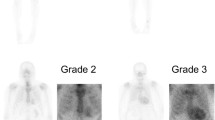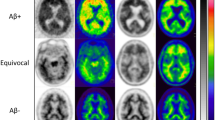Abstract
The objective of the present work was to evaluate the potential of deep learning tools for characterizing the presence of cardiac amyloidosis from early acquired PET images, i.e. 15 min after [18F]-Florbetaben tracer injection. 47 subjects were included in the study: 13 patients with transthyretin-related amyloidosis cardiac amyloidosis (ATTR-CA), 15 patients with immunoglobulin light-chain amyloidosis (AL-CA), and 19 control-patients (CTRL). [18F]-Florbetaben PET/CT images were acquired in list mode and data was sorted into a sinogram, covering a time interval of 5 min starting 15 min after the injection. The resulting sinogram was reconstructed using OSEM iterative algorithm. A deep convolutional neural network (CAclassNet) was designed and implemented, consisting of five 2D convolutional layers, three fully connected layers and a final classifier returning AL, ATTR and CTRL scores. A total of 1107 2D images (375 from AL-subtype patients, 312 from ATTR-subtype, and 420 from Controls) have been considered in the study and used to train, validate and test the proposed network. CAclassNet cross-validation resulted with train error mean ± sd of 2.001% ± 0.96%, validation error of 4.5% ± 2.26%, and net accuracy of 95.49% ± 2.26%. Network test error resulted in a mean ± sd values of 10.73% ± 0.76%. Sensitivity, specificity, and accuracy evaluated on the test dataset were respectively for AL-CA sub-type: 1, 0.912, 0.936; for ATTR-CA: 0.935, 0.897, 0.972; for control subjects: 0.809, 0.971, 0.909. In conclusion, the proposed CAclassNet model seems very promising as an aid for the clinician in the diagnosis of CA from cardiac [18F]-Florbetaben PET images acquired a few minutes after the injection.




Similar content being viewed by others
Data availability
Acquired PET images, duly anonymized, are made available to anyone interested. Custom code is available to anyone interested.
References
Wechalekar AD, Gillmore JD, Hawkins PN (2016) Systemic amyloidosis. Lancet 387(10038):2641–2654. https://doi.org/10.1016/S0140-6736(15)01274-X
Sipe JD, Benson MD, Buxbaum JN et al (2016) Amyloid fibril proteins and amyloidosis: chemical identification and clinical classification International Society of Amyloidosis 2016 Nomenclature Guidelines. Amyloid 23(4):209–213. https://doi.org/10.1080/13506129.2016.1257986
Martinez-Naharro A, Hawkins PN, Fontana M (2018) Cardiac amyloidosis. Clin Med (Northfield Il) 18(Suppl 2):30–35. https://doi.org/10.7861/clinmedicine.18-2-s30
Rosenzweig M, Landau H (2011) Light chain (AL) amyloidosis: update on diagnosis and management. J HematolOncol. https://doi.org/10.1186/1756-8722-4-47
Ruberg FL, Grogan M, Hanna M, Kelly JW, Maurer MS (2019) Transthyretin amyloid cardiomyopathy: JACC state-of-the-art review. J Am CollCardiol 73(22):2872–2891. https://doi.org/10.1016/j.jacc.2019.04.003
Gillmore JD, Wechalekar A, Bird J et al (2015) Guidelines on the diagnosis and investigation of AL amyloidosis. Br J Haematol 168(2):207–218. https://doi.org/10.1111/bjh.13156
Gillmore JD et al (2016) Nonbiopsy diagnosis of cardiac transthyretine amyloidosis. Circulation 133:2404–2412
Mollee P, Renaut P, Gottlieb D, Goodman H (2014) How to diagnose amyloidosis. Intern Med J 44(1):7–17. https://doi.org/10.1111/imj.12288
Santarelli MF, Scipioni M, Genovesi D, Giorgetti A, Marzullo P, Landini L (2020) Imaging techniques as an aid in the early detection of cardiac amyloidosis. Curr Pharm Des. https://doi.org/10.2174/1381612826666200813133557
Chacko L, Martone R, Cappelli F, Fontana M (2019) Cardiac amyloidosis: updates in imaging. CurrCardiol Rep 21(9):108. https://doi.org/10.1007/s11886-019-1180-2
Lee S-P, Park J-B, Kim H-K, Kim Y-J, Grogan M, Sohn D-W (2019) Contemporary imaging diagnosis of cardiac amyloidosis. J Cardiovasc Imaging 27(1):1. https://doi.org/10.4250/jcvi.2019.27.e9
Giorgetti A, Genovesi D, Emdin M (2018) Cardiac amyloidosis: the starched heart. J NuclCardiol. https://doi.org/10.1007/s12350-018-1399-0
Slart RHJA, Glaudemans AWJM, Noordzij W, Bijzet J, Hazenberg BPC, Nienhuis HLA (2019) Time for new imaging and therapeutic approaches in cardiac amyloidosis. Eur J Nucl Med Mol Imaging 46(7):1402–1406. https://doi.org/10.1007/s00259-019-04325-4.GiorgettiA
Genovesi D, Milan E et al (2019) Cardiac amyloidosis. ClinTransl Imaging 7(1):21–32. https://doi.org/10.1007/s40336-018-00311-2
Di Bella G, Pizzino F, Minutoli F et al (2014) The mosaic of the cardiac amyloidosis diagnosis: role of imaging insubtypes and stages of the disease. Eur Heart J Cardiovasc Imaging 15(12):1307–1315. https://doi.org/10.1093/ehjci/jeu158
Kyriakou P, Mouselimis D, Tsarouchas A, Rigopoulos A, Bakogiannis C, Noutsias M, Vassilikos V (2018) Diagnosis of cardiac amyloidosis: a systematic review on the role of imaging and biomarkers. BMC CardiovascDisord 18(1):221
Bokhari S, Castano A, Pozniakoff T, Deslisle S, Latif F, Maurer MS (2013) (99m)Tc-pyrophosphate scintigraphy for differentiating light- chain cardiac amyloidosis from the transthyretin-related familial and senile cardiac amyloidoses. CircCardiovasc Imaging 6:195–201
Perugini E, Guidalotti PL, Salvi F, Cooke RMT, Pettinato C, Riva L et al (2005) Noninvasive etiologic diagnosis of cardiac amyloidosis using 99mTc-3,3-diphosphono-1,2-propanodicarboxylic acid scintigraphy. J Am CollCardiol 46:1076–1084
Santarelli MF, Genovesi D, Positano V, Di Sarlo R, Scipioni M, Giorgetti A, Landini L, Marzullo P (2020) Cardiac amyloidosis detection by early bisphosphonate (99mTc-HMDP) scintigraphy. J Nucl Cardiology. https://doi.org/10.1007/s12350-020-02239-5
Andrikopoulou E, Bhambhvani P (2019) Nuclear imaging of cardiac amyloidosis. J NuclCardiol 26(2):505–508
Treglia G, Glaudemans AWJM, Bertagna F, Hazenberg BPC, Erba PA, Giubbini R et al (2018) Diagnostic accuracy of bone scintigraphy in the assessment of cardiac transthyretin-related amyloidosis: a bivariate meta-analysis. Eur J Nucl Med Mol Imaging 45(11):1945–1955
Kim YJ, Ha S, Kim Y (2020) Cardiac amyloidosis imaging with amyloid positron emission tomography: a systematic review and meta-analysis. J NuclCardiol 27(1):123–132
Law WP, Wang WYS, Moore PT, Mollee PN, Ng ACT (2016) Cardiac amyloid imaging with 18F-florbetaben PET: a pilot study. J Nucl Med 57(11):1733–1739
Genovesi D, Vergaro G, Emdin M, Giorgetti A, Marzullo P (2017) PET-CT evaluation of amyloid systemic involvement with [18F]-florbetaben in patient with proved cardiac amyloidosis: a case report. J NuclCardiol 24(6):2025–2029
Dorbala S, Vangala D, Semer J et al (2014) Imaging cardiac amyloidosis: a pilot study using 18F-florbetapir positron emission tomography. Eur J Nucl Med Mol Imaging 41(9):1652–1662
Kircher M, Ihne S, Brumberg J et al (2019) Detection of cardiac amyloidosis with 18F-Florbetaben-PET/CT in comparison to echocardiography, cardiac MRI and DPD-scintigraphy. Eur J Nucl Med Mol Imaging 46(7):1407–1416
Genovesi D, Vergaro G, Giorgetti A, Marzullo P, Scipioni M, Santarelli MF, Pucci A, Buda G, Volpi E, Emdin M (2020) [18F]-florbetaben PET/CT for differential diagnosis among cardiac immunoglobulin light chain, transthyretin amyloidosis, and mimicking conditions. J Am CollCardiolImg. https://doi.org/10.1016/j.jcmg.2020.05.031
Latif J, Xiao C, Imran A, Tu S (2019) Medical imaging using machine learning and deep learning algorithms: a review. 2019 2 IntConfComput Math EngTechnoliCoMET. https://doi.org/10.1109/ICOMET.2019.8673502
Yadav SS, Jadhav SM (2019) Deep convolutional neural network based medical image classification for disease diagnosis. J Big Data. https://doi.org/10.1186/s40537-019-0276-2
Martin-Isla C, Campello VM, Izquierdo C et al (2020) Image-based cardiac diagnosis with machine learning: a review. Front Cardiovasc Med 7:1–19. https://doi.org/10.3389/fcvm.2020.00001
Zhang J, Gajjala S, Agrawal P, Tison GH, Hallock LA, Beussink- Nelson L et al (2018) Fully automated echocardiogram interpretation in clinical practice: feasibility and diagnostic accuracy. Circulation 138:1623–1635. https://doi.org/10.1161/CIRCULATIONAHA.118.034338
Betancur J, Hu LH, Commandeur F, Sharir T, Einstein AJ, Fish MB et al (2019) Deep learning analysis of upright-supine high-efficiency SPECT myocardial perfusion imaging for prediction of obstructive coronary artery disease: a multicenter study. J Nucl Med 60:664–670. https://doi.org/10.2967/jnumed.118.213538
Choi H (2018) Deep learning in nuclear medicine and molecular imaging: current perspectives and future directions. Nucl Med Mol Imaging 52:109–118. https://doi.org/10.1007/s13139-017-0504-7
Kim J, Suh HY, Kim J, Suh HY, Ryoo HG et al (2019) Amyloid PET quantification via end-to-end training of a deep learning. Nucl Med Mol Imaging 53:340–348. https://doi.org/10.1007/s13139-019-00610-0
Son HJ, Oh JS, Oh M et al (2020) The clinical feasibility of deep learning-based classification of amyloid PET images in visually equivocal cases. Eur J Nucl Med Mol Imaging 47:332–341. https://doi.org/10.1007/s00259-019-04595-y
Weiner MW, Veitch DP, Aisen PS, Beckett LA, Cairns NJ, Cedarbaum J et al (2020) Alzheimer′s disease neuroimaging initiative. Application of deep learning to predict standardized uptake value ratio and amyloid status on 18F-florbetapir PET using ADNI data. Am J Neuroradiol 41(6):980–986. https://doi.org/10.3174/ajnr.A6573
Lecun Y, Bengio Y, Hinton G (2015) Deep learning. Nature 521(7553):436–444. https://doi.org/10.1038/nature14539
Ker J, Wang L, Rao J, Lim T (2017) Deep learning applications in medical image analysis. IEEE Access. https://doi.org/10.1109/ACCESS.2017.2788044
Srivastava N, Hinton G, Krizhevsky A, Sutskever I, Salakhutdinov R (2014) Dropout: a simple way to prevent neural networks from overfitting. J Mach Learn Res. 15:1929–1958
Stone M (1974) Cross-validatory choice and assessment of statistical predictions. J R Stat SocSer B. https://doi.org/10.1111/j.2517-6161.1974.tb00994.x
Betancur J, Commandeur F, Motlagh M et al (2018) Deep learning for prediction of obstructive disease from fast myocardial perfusion SPECT: a multicenter study. JACC Cardiovasc Imaging 11(11):1654–1663. https://doi.org/10.1016/j.jcmg.2018.01.020
Glaudemans AWJM, Slart RHJA, Zeebregts CJ et al (2009) Nuclear imaging in cardiac amyloidosis. Eur J Nucl Med Mol Imaging 36(4):702–714. https://doi.org/10.1007/s00259-008-1037-1
Author information
Authors and Affiliations
Corresponding author
Ethics declarations
Conflict of interest
The authors declare that they have no conflict of interest.
Ethical approval
The study was approved by the institutional ethics committee and by the AIFA (Agenzia Italiana del Farmaco) committee. The study complied with the Declaration of Helsinki.
Informed consent
Informed consent was obtained from all individual participants included in the study.
Additional information
Publisher's Note
Springer Nature remains neutral with regard to jurisdictional claims in published maps and institutional affiliations.
Rights and permissions
About this article
Cite this article
Santarelli, M.F., Genovesi, D., Positano, V. et al. Deep-learning-based cardiac amyloidosis classification from early acquired pet images. Int J Cardiovasc Imaging 37, 2327–2335 (2021). https://doi.org/10.1007/s10554-021-02190-7
Received:
Accepted:
Published:
Issue Date:
DOI: https://doi.org/10.1007/s10554-021-02190-7




